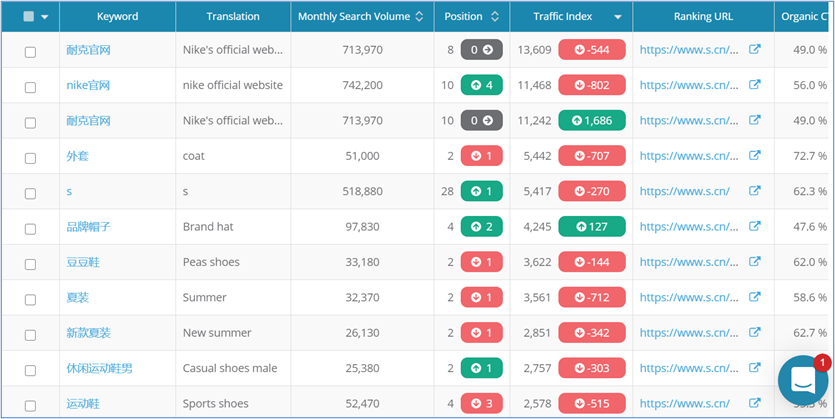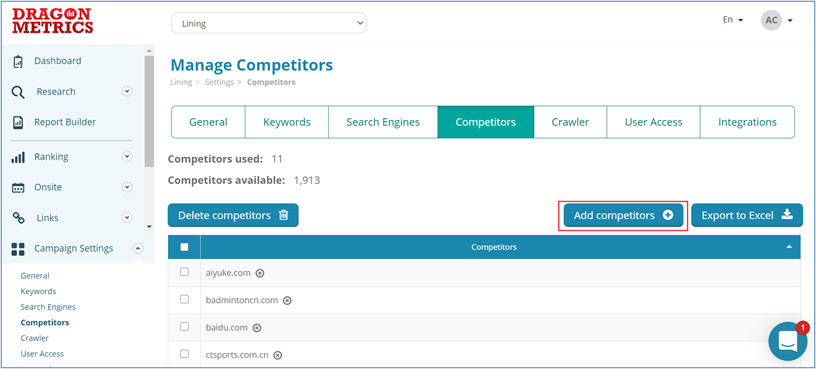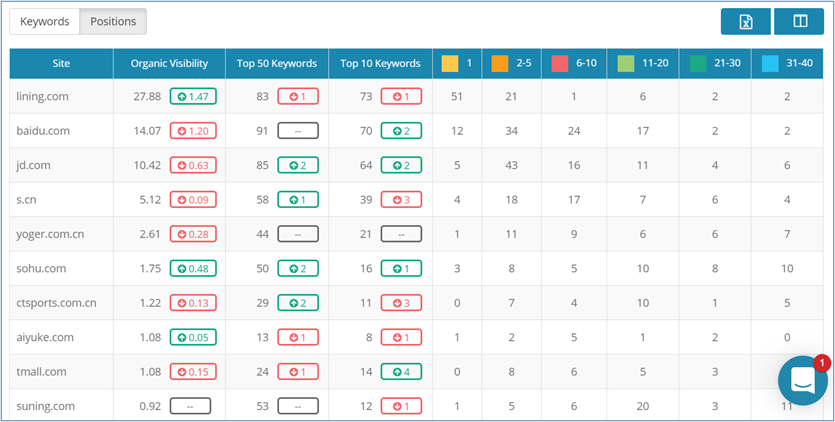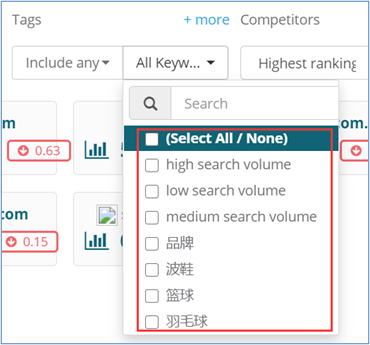China SEO: Beat your Competitors with Strategic Keyword Analysis
With the ability to answer the world’s billions of daily queries, search engine results pages (SERPs) have become a battlefield—competitors strategize and fight for visibility and clicks to ultimately win the content-to-conversions war.
And as one Chinese proverb goes: “Only by knowing yourself—and the enemy—can you win every battle.”
In China SEO terms: Surveilling your competitors arms your strategy against their strengths and weaknesses. To this end, keyword analysis is the weapon of choice.
Let’s examine how to optimize against your competitors’ keyword rankings on Baidu, China’s top search engine with 222+ million active users, using Dragon Metrics, China’s top SEO platform that automates reports across the world’s major search engines.
Step 1: Identify Your Competitors in China
Before you can start competitor keyword analysis, you must first identify your competitor through market research and SERPs.
To demonstrate, let’s consider Lining (or Li-Ning), a popular Chinese B2C e-commerce website targeting the local sports market.
From a market perspective, its direct competitors are JD Sports, S.cn, Taobao*, Dangdang, Suning, and Tmall—an array of B2C e-commerce powerhouses. This is useful information to have, particularly for optimizing product-based content.
For a more nuanced picture of your competitors, regardless of market or industry, you need to identify your SERP competitors—not just your business competitors.
For this, let’s look at how Dragon Metrics uncovers Lining’s competitors on the Baidu SERP:


Inside Dragon Metrics, you can select the search engine (in this case, “Baidu—China”) and enter the domain (in this case, “lining.com”) to generate a competitor list of up to 50 results.
Based on Lining’s top 10 organic SERP competitors, we can find interesting insights:
- B2C sporting goods sites JD.com, S.cn, and Yoger.com.cn ranked 2nd, 3rd, and 8th, respectively.
- Non-sport related sites Suning, Tmall, and Dangdang ranked 11th, 12th, and 30th, respectively.
- Baidu ranked 1st given that Baidu-specific properties (like Baidu Baike or Baidu Experience) will always feature highest on the SERP.
- Zhihu (a Q&A site), Hupu (a sports forum), and Sohu and Sina (both news platforms) all had relatively good rankings, indicating that Lining’s competitors can come in various forms.
- 1688.com, a B2B e-commerce site, even managed to rank 9th.
According to these findings, we can add JD.com, S.cn, Yoger.com.cn, Suning.com, and Tmall.com to Lining’s competitor list. In addition to optimizing against these B2C sites, Lining can also manage its online reputation using Baidu-specific properties, Q&A sites, and news platforms that rank within their top 10 SERP competitors.
*Note: The Taobao site does not allow Baidu spiders to crawl and cannot be a competitor on the Baidu SERP.
Step 2: Identify Target Keywords
Step 2 is identifying the keywords that surface your competitors on the SERP.
Obviously, competitors will not reveal their target keywords, but you can use Dragon Metrics to identify the words for which they rank.
For instance, let’s identify keywords from S.cn (Lining’s competitor): At the time of our research, Dragon Metrics showed that S.cn ranked on the first three pages of the Baidu SERP for 86,800 keywords.
Dragon Metrics also lets you view additional keyword metrics, like search volume, ranking, and ranking URL.


Since not every competitor keyword will be relevant to your SEO strategy, you can simply export the Dragon Metrics report as an Excel file. From there, you can filter/remove branded keywords and select only those that relate to your products or service. In Lining’s case, these will include sports shoes, sportswear, sports equipment, etc.
So, after examining your own keywords against your competitors’, you will have a complete list of target keywords to feed into your SEO.
Step 3: Monitor Competitor Keyword Rankings
While there are many tools for competitor keyword research on Google’s SERP, very few can also support Chinese search engines. Dragon Metrics does both: Google and Baidu, Sogou, 360 Search, Shenma, and more.
Within the platform, you can create campaigns to manage your site’s keywords and your competitors’ keywords to monitor rankings. You can also sort competitors in lists or subfolders through their site domains.


The Tracked Competitors tool compares the site metrics of your competitors in a selected campaign. The 9 highest-ranked competitors in a campaign will be displayed by default, but this number can be changed any time to view more or less.

Furthermore, you can track keyword ranking by not just search engine but also device, because desktop searches can generate different results than mobile searches.
Dragon Metrics: Filter keywords by search engine and device
For critical keywords, you can separate them into groups to track the data more precisely based on key metrics like search volume.
Dragon Metrics: Select keyword groups
Step 4: Analyze Keyword Ranking Data
Once you’ve grouped your target keywords and competitors, you’ll need to gain insights from the data on how to optimize your site, focus on well-converting keywords, and boost overall web traffic.
You can analyze keyword ranking data on Dragon Metrics using two table formats: Positions Table and Keywords Table.
Dragon Metrics Positions Table
For each competitor website, the Positions Table showcases their organic visibility score and the number of ranked keywords positioned on each SERP. You can export this data by clicking the button towards the upper-right-hand-side of the table.

Dragon Metrics Keywords Table
In the Keywords Table, each row contains a different tracked keyword and there is a column for each tracked competitor.
Clicking on a keyword reveals even more details about its monthly search volume, direct translation (if in a foreign language), and preferred landing page.
Once again, this data can be exported and in case you forget what competitor is being tracked, simply hover your cursor over the table header to reveal their URLs.


As you can see, the Positions Table illustrates the gap between your website and your competitors’ in terms of organic visibility and keyword ranking on SERPs.
The Keywords Table shows which keywords perform particularly well and how your competitors stack against them.
Both sets of data will help you better understand your competitors and how to win against them.
***
Your competitors are not static; their SEO strategies can change at any time. Whether introducing a new product or improving keyword performance, you should keep a steady eye on your competitive data and continue researching strong competitors—so that you can beat them!
Using Dragon Metrics data, you can identify the trump card of your competitors’ ranked pages—whether that’s creating more engaging content, a smoother user experience, a better optimized site structure, etc.—and learn from them to improve your own website.
This is why monitoring your competitors’ keyword rankings is so significant to SEO, not just in China but around the world—with the help of Dragon Metrics.
Pro-Tip: As The Egg’s sister company, Dragon Metrics is a proprietary tool developed as the first truly global SEO platform that provides rank tracking, onsite optimization reports, link management, keyword research tools, and more for search engines around the world. Here, we look specifically at Dragon Metrics’ prowess on Baidu, China’s #1 search engine with 222+ million active users, but Dragon Metrics works for all of the world’s major search engines.








